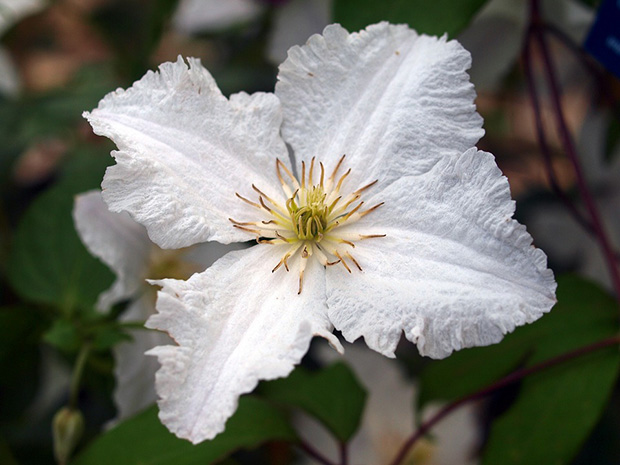Clematis Wilt is a summer problem. In spring, clematis will be completely healthy. It’s very discouraging to see clematis beginning to wilt. The leaves look for all the world as if they are affected by drought, you may think it needs water, but it just gets worse as leaf veins turn purple, leaves blacken and die. Even more discouraging is the speed with which this disease moves. There is still much debate among growers about the mechanism by which wilt happens to clematis. It may be caused first by a vascular immaturity allowing the fungus, Ascochyta clematidina, to attack the plant.
What to Watch For
- Wilted leaves giving the appearance of a drought-stricken plant. Leaves at the top of the stem or vine are affected.
- Leaf veins turn purple, then stems and leaves quickly blacken and die.
- If leaves at the bottom of the plant are wilting that indicates a watering or cultural issue, not clematis wilt.
What to Do
- If not every main stem or vine is affected immediately remove those stems to a few inches below the ground.
- If the entire plant is affected, remove all stems to a few inches below the ground.
- Put all removed stems in the trash at a distance from the garden.
- Water the plant thoroughly after cleaning up debris from wilt.
The clematis should re-grow the next year and may not experience wilt again.
Clematis Wilt may or may not be a death sentence since the fungus doesn’t attack the roots, just the upper parts of the plant. Large-flowered clematis is more susceptible than the small-flowered cultivars.
Planting Clematis
Planting clematis correctly can make a difference in the likelihood of A. clematindina taking hold. If you plant the clematis well and deeply, even if wilt attacks, you have a good chance of seeing the clematis come back the next year or the one after. Plant in full sun, but where the roots can remain cool. Mulching will help. This means 6 hrs a day. Pick a spot that gives the clematis some space and air flow; in other words, don’t squeeze it in a limited area where it will be in contact with dense foliage from other plants. Clematis likes to be planted in rich well-draining soil. They also do best in soil that is a little less acid than most perennials. A pH of 7.0 is good. Plant in humus rich soil. Remember that just because your soil is top notch it doesn’t mean that the pH is where it should be. Plant clematis 2 to 4 inches lower in the ground than the level in the pot. A good marker is to plant with 2 sets of leaves under the surface. Fill the hole gently trying not to hurt the stems.
How to Amend the Soil for Clematis
Sandy soil: mix in peat moss, compost and manure. When refilling after putting the plant in the ground use ½ the soil you took out and ½ the new mix of peat, compost and manure. Clay soil: Use ½ the soil that you took out of the hole and the other ½ a mix of compost, sand or clay soil conditioner (Espoma’s soil perfector).
Clematis Care Matters
Be careful when pruning! Unsanitary conditions when pruning can give A. clematidina just the opportunity it needs to attack your clematis. Any wound or injured stems can invite wilt. Keep the area clean! Don’t let garden leaves or debris sit around the bottom of the plant. Mulching the over the root zone is a good idea for clematis as well as not disturbing the soil too much… if you don’t mulch but do a strong weeding in the area, you may be unleashing the fungus. Even water splash can carry the fungus, so try to keep the hose away from clematis, using a soaker hose at the bottom. In spring, use a good granular food such as Plant-Tone. Printable version of Clematis Wilt

